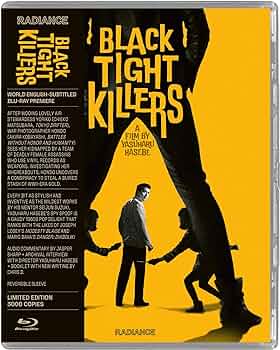We open on some awesome jazzy music over the production logo which leads into the introduction of our main man, Daisuke Honda, war photographer, in the midst of the most fireworks-filled battle sequence I’ve come across in a film. Then we get a totally groovy go-go dancing opening credits sequence after which we jump forward to Honda hitting on a sexy stewardess named Yuriko on the plane ride back home from the war in Vietnam. They hit it off and adjourn to a bar after landing, but their date is unfortunately interrupted by go-go dancing female ninjas showing up to kidnap Yuriko. The rest of the plot involves Honda pursuing the kidnappers and getting mixed up in a convoluted scheme involving WWII-era gold that Yuriko’s father hid away somewhere. Also more go-go dancing.
This first film from Yasuharu Hasebe (Massacre Gun, Stray Cat Rock) is a vibrant pop art spectacle that is as joyful and entertaining as it is hard to follow. Sometimes the plot just doesn’t matter. When the music is this good, the action this fun, the characters this out-sized, the sets and costumes this eye-poppingly garish, one doesn’t need a coherent storyline to have a great time. If you only know Hasebe from his grim, visceral crime films like Massacre Gun, Retaliation and the brutal, offensive Assault! Jack the Ripper, you will be pleasantly surprised by how loose and free Hasebe feels here. The most obvious comparison you can make here is to Seijun Suzuki’s Tokyo Drifter from the same year (lead actress Chieko Matsubura appears in both). This comparison isn’t surprising since Hasebe considered Suzuki one of his primary influences and mentors, both in style and tone. The film also shares a similar tone to other lively ’60s spy thrillers like Danger Diabolik and the James Bond film Goldfinger from not only its candy-colored aesthetic but also its embracing of absurd weapons (killer gum and razor sharp vinyl LPs for instance).
While the disc is light on the details of the source of the transfer (it merely states that a digital file was provided by Nikkatsu from an HD source with additional work done by Radiance), the results are nonetheless a delight. The movie looks absolutely striking with its bold visuals capturing very well with a minimum of distractions. The mono audio track is also quite nicely done with the near constant awesome music coming in loud and clear (I’d selfishly like a stereo or even 5.1 track to experience this great score in an even more immersive environment but that’s just nitpicking). The main extra included here is a great audio commentary track from critic and author Jasper Sharp (who gave us the excellent books Midnight Eye Guide to New Japanese Film and Behind the Pink Curtain: The Complete History of Japanese Sex Cinema). Sharp is highly versed on all kinds of trivia related to the film itself, director Hasebe, other cast and crew and even the history of the Nikkatsu Corporation. This track is a veritable bounty of Japanese cinema info. Also included is an archival interview with director Hasebe primarily discussing his relationship with Seijun Suzuki and Suzuki’s influence on him. As with other Radiance releases we also get a physical booklet that includes an essay by Chris D. (author of Gun & Sword: An Encyclopedia of Japanese Gangster Films 1955-1980) on both Black Tight Killers specifically and Hasebe’s film career as a whole. While there’s overlap between what’s covered in the essay and Jasper Sharp’s commentary, it’s still a nice more succinct inclusion for those not wanting to listen to a full commentary track.
I absolutely love when I’m presented with a hidden gem that wasn’t even on my radar, and Radiance has once again met and exceeded my needs with a film that is such a fun, electric experience that it’s one of the easiest recommendations I’ve come across in a while.

